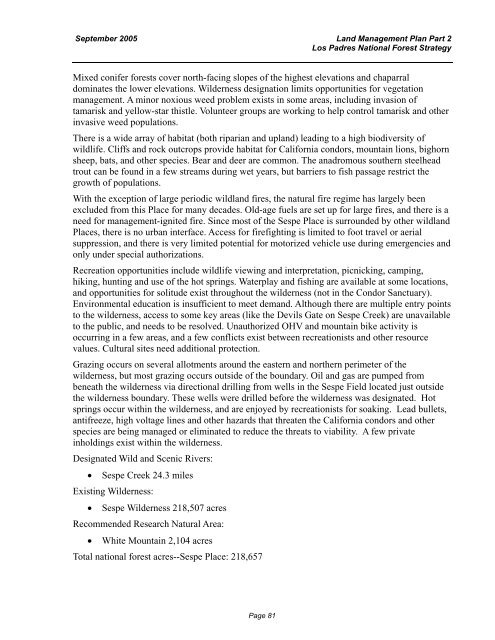Land Management Plan - Part 2 Los Padres National Forest Strategy
Land Management Plan - Part 2 Los Padres National Forest Strategy
Land Management Plan - Part 2 Los Padres National Forest Strategy
Create successful ePaper yourself
Turn your PDF publications into a flip-book with our unique Google optimized e-Paper software.
September 2005 <strong>Land</strong> <strong>Management</strong> <strong>Plan</strong> <strong>Part</strong> 2<br />
<strong>Los</strong> <strong>Padres</strong> <strong>National</strong> <strong>Forest</strong> <strong>Strategy</strong><br />
Mixed conifer<br />
forests cover north-facing slopes of the highest elevations and chaparral<br />
dominates the lower elevations. Wilderness designation limits opportunities for vegetation<br />
management. A minor noxious weed problem exists in some areas, including invasion of<br />
tamarisk and yellow-star thistle. Volunteer groups are working to help control tamarisk and other<br />
invasive weed populations.<br />
There is a wide array of habitat (both riparian and upland) leading to a high biodiversity of<br />
wildlife. Cliffs and rock outcrops provide habitat for California condors, mountain lions, bighorn<br />
sheep, bats, and other species. Bear and deer are common.<br />
The anadromous southern steelhead<br />
trout can be found in a few streams during wet years, but barriers to fish passage restrict the<br />
growth of populations.<br />
With the exception of large periodic wildland fires, the natural<br />
fire regime has largely been<br />
excluded from this Place for many decades. Old-age fuels are set up for large fires, and there is a<br />
need for management-ignited fire. Since most of the Sespe Place is surrounded by other wildland<br />
Places, there is no urban interface. Access for firefighting<br />
is limited to foot travel or aerial<br />
suppression, and there is very limited potential for motorized<br />
vehicle use during emergencies and<br />
only under special authorizations.<br />
Recreation opportunities include wildlife viewing and interpretation,<br />
picnicking, camping,<br />
hiking, hunting and use of the hot springs. Waterplay<br />
and fishing are available at some locations,<br />
and opportunities for solitude exist throughout the wilderness<br />
(not in the Condor Sanctuary).<br />
Environmental education is insufficient to meet demand.<br />
Although there are multiple entry points<br />
to the wilderness, access to some key areas (like the Devils<br />
Gate on Sespe Creek) are unavailable<br />
to the public, and needs to be resolved. Unauthorized OHV and mountain bike activity is<br />
occurring in a few areas, and a few conflicts exist between recreationists and other resource<br />
values. Cultural sites need additional protection.<br />
Grazing occurs on several allotments around the eastern and northern perimeter of the<br />
wilderness, but most grazing occurs outside of the boundary. Oil and gas are pumped from<br />
beneath the wilderness via directional drilling from wells in the Sespe Field located just outside<br />
the wilderness boundary. These wells were drilled before the wilderness was designated. Hot<br />
springs occur within the wilderness, and are enjoyed by recreationists for soaking. Lead bullets,<br />
antifreeze, high voltage lines and other hazards that threaten the California condors and other<br />
species are being managed or eliminated to reduce the threats to viability. A few private<br />
inholdings exist within the wilderness.<br />
Designated Wild and Scenic Rivers:<br />
• Sespe Creek 24.3 miles<br />
Existing Wilderness:<br />
• Sespe Wilderness 218,507 acres<br />
Recommended Research Natural Area:<br />
• White Mountain 2,104 acres<br />
Total national forest acres--Sespe Place: 218,657<br />
Page 81
















